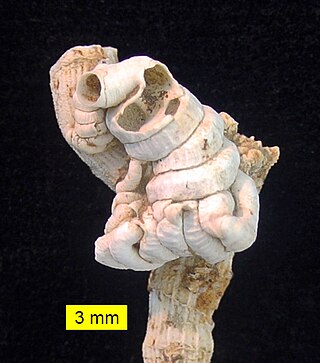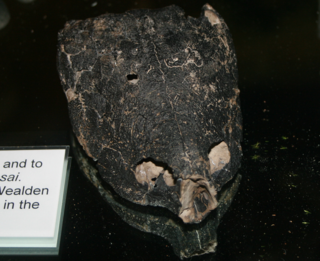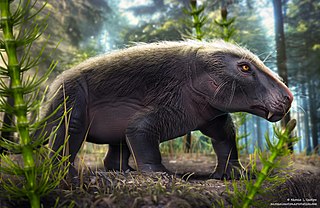
Parazoa are a taxon with sub-kingdom category that is located at the base of the phylogenetic tree of the animal kingdom in opposition to the sub-kingdom Eumetazoa; they group together the most primitive forms, characterized by not having proper tissues or that, in any case, these tissues are only partially differentiated. They generally group a single phylum, Porifera, which lack muscles, nerves and internal organs, which in many cases resembles a cell colony rather than a multicellular organism itself. All other animals are eumetazoans, which do have differentiated tissues.

Catagonus is a genus of peccaries that contains the living Chacoan peccary and several extinct species. The genus has always been restricted to South America.
Anasibirites is an extinct genus of ammonoid cephalopod from the lower upper Smithian Wasatchites distractus Zone.

Fossilworks is a portal which provides query, download, and analysis tools to facilitate access to the Paleobiology Database, a large relational database assembled by hundreds of paleontologists from around the world.

Homosclerophorida is an order of marine sponges. It is the only order in the monotypic class Homoscleromorpha. The order is composed of two families: Plakinidae and Oscarellidae.
Rhytidosteoidea is a superfamily of Temnospondyli, early amphibian species that existed during the Carboniferous, Permian, and Triassic periods. The taxon was established in 1965 to accommodate two new species of Deltasaurus, the author recognising an alliance with previously described genera.

Euthyneura is a taxonomic infraclass of snails and slugs, which includes species exclusively from marine, aquatic and terrestrial gastropod mollusks in the clade Heterobranchia.
Metaceratodus is an extinct genus of prehistoric lungfish in the family Ceratodontidae, with an indeterminate specimen known from the Late Triassic (Norian)-aged Lissauer Breccia of Poland and more complete specimens known from the Late Cretaceous of Queensland, Australia and Argentina. The genus was named and described by Frederick Chapman in 1914.

Barrosasaurus is a genus of titanosaurian sauropod dinosaur, first described by paleontologists Leonardo Salgado and Rodolfo Coria in 2009. The fossils, consisting of three fossil dorsal (back) vertebrae, are well-preserved but incomplete. They were discovered in the Anacleto Formation of the Neuquén province of western Argentina. The type species is Barrosasaurus casamiquelai. The genus name is named after the Sierra Barrosa in Neuquén. The specific epithet honours the Argentinian paleontologist Rodolfo Magín Casamiquela. It's been estimated to be 18 meters in length and 13.5 tonnes in weight.

Palaeovaranus is an extinct genus of varanoid lizards from the Late Eocene of France and Germany. It contains two species, Palaeovaranus cayluxensis and Palaeovaranus giganteus. The genus was first named by Henri Filhol in 1877, but he had named the species Palaeovaranus cayluxi earlier as Palaeosaurus cayluxi in 1873, and as Necrosaurus cuxleyi in 1876 after it was discovered that Palaeosaurus was preoccupied. However, he failed to provide any kind of valid description, which renders Karl Alfred Ritter von Zittel's 1887 description of the taxon as the valid authority on its validity. Despite this, the name Necrosaurus was the widely used name in the literature afterwards until 2017, when the name Paleovaranus was revived. It is placed in the family Palaeovaranidae.

Petaloconchus intortus is an extinct species of sea snail, a marine gastropod mollusk in the family Vermetidae, the worm snails or worm shells.
Clarkina is an extinct genus of conodonts. It is considered to be an offshore, outer shelf or basinal, deep-water taxon.

Cribrospongia is an extinct genus of prehistoric sponges in the family Cribrospongiidae. The species C. elegans is from the Jurassic period and has been found in Germany.

Helochelydra is an extinct genus of extinct stem turtle known from the Early Cretaceous (Barremian) of the Isle of Wight, southern England.

Siriusgnathus is a traversodontid cynodont from the Carnian channel sandstones and mudstones of the Candelária Formation, belonging to the Santa Maria Supersequence of the Paraná Basin in southeastern Brazil. It includes one species, Siriusgnathus niemeyerorum and was described in 2018. The species epithet refers to the Niemeyer locality in Agudo, Rio Grande do Sul. It was found together with various archosauromorphs, dinosauromorphs and other cynodonts, such as Brasilitherium riograndensis, Brasilodon quadrangularis, Irajatherium hernandezi and Prozostrodon brasiliensis.

The Ganigobis Formation is a Late Carboniferous (Gzhelian) to Early Permian (Artinskian) geologic formation of the Dwyka Group in the ǁKaras Region of southeastern Namibia and the Northern Cape of South Africa. The widespread formation was deposited in the Aranos and Karoo Basins of southern Africa.

Eocyathispongia is a genus of sponge-like organisms which lived in the Ediacaran period about 60 million years before the Cambrian. The current fossil record has found this genus in only one location, the Doushantuo Formation in Guizhou, China. It lived in the shallow parts of seas, filter feeding.

Proschismotherium is an extinct genus of ground sloth of the family Megalonychidae, endemic to Argentina during the Early Miocene. It lived from 17.5 mya — 16.3 mya, existing for approximately 1.2 million years. The type, and only, species, P. oppositum, was named in 1902 by Florentino Ameghino based on a single specimen found in the Santacrucian-aged Colpodon Beds of Argentina. Ameghino in 1902 placed Proschismotherium in the Megatheriidae, alongside Hapaloides, which was its sister taxon.

Thanatosdrakon is a genus of quetzalcoatline azhdarchid pterosaur from the Late Cretaceous Plottier Formation of the Neuquén Basin in western Argentina. The genus name is derived from the Greek words thanatos (=death) and drakon (=dragon), while the specific name is a Quechuan word meaning "flying serpent" and refers to the Incan deity Amaru. The type and only species is Thanatosdrakon amaru, known from two specimens consisting of several well-preserved axial and appendicular bones including material previously undescribed in giant azhdarchids. Thanatosdrakon is one of the oldest known members of the Quetzalcoatlinae. T. amaru lived from about 90 to 86 million years ago.
Hapaloides is an extinct genus of ground sloth of the family Megalonychidae, endemic to Argentina during the Early Miocene. It lived from 21.0 mya to 17.5 mya, existing for approximately 3.5 million years.
















